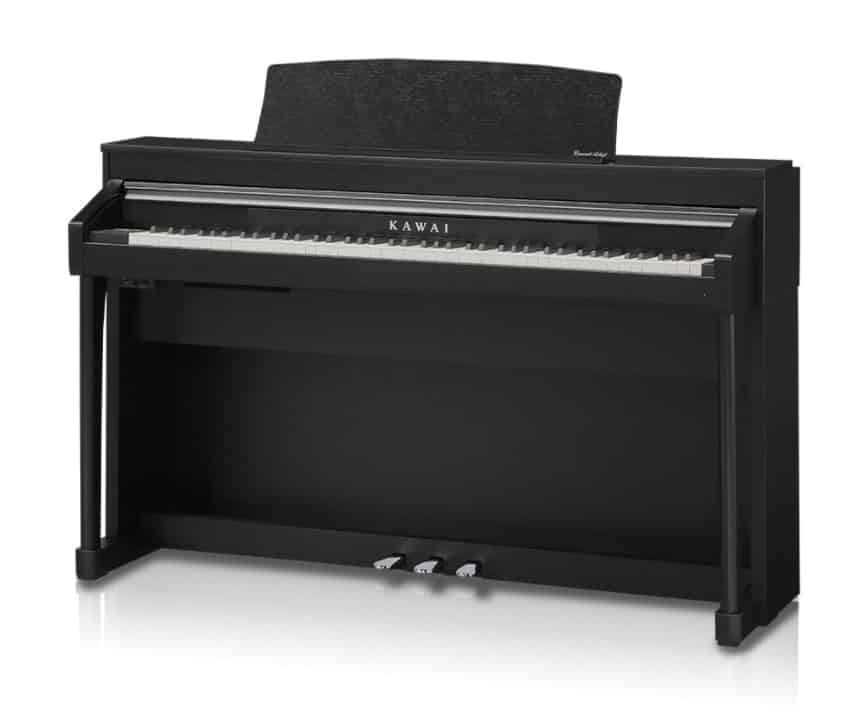
Many of the recent piano reviews I have written have drawn their source material from the acoustic range of pianos both old and new. This review concerns the Kawai CA67, which is categorized as a digital piano. (It may be of interest to the reader to note that the CA67 has been superseded by the newer CA79). The current ‘CA’ range includes the 49, 59, 79, and 99. Each of these digital pianos is impressive and worthy of serious consideration if you are thinking of investing in a new instrument.
Kawai CA67 Piano Review
One of the biggest selling points of this model Kawai is that you had the sounds of some of the very best of the Kawai grand piano available to you through this keyboard. These included the Shigeru highly praised Kawai EX piano as well as the SK-5. Not only does the CA67 have these world-class pianos as standard but the instrument comes with a ‘Grand Feel’ (2), wooden-key action with ebony and ivory ‘touch surfaces’ and ‘let-off’ mechanism. This offers the player an exceptional playing and realistic performing experience as it genuinely aims to model the action and feel of Kawai’s top-end pianos.
It is one thing to offer the sounds of these great acoustic pianos, but without cutting-edge sampling then the offer falls flat. Kawai is not in the business of shortchanging the buyers of the CA67. The sampling and recording techniques used to capture the sounds of the Shigeru EX range have been meticulously undertaken. The acoustic grand pianos were carefully captured across the full 88-key compass using a process Kawai describes as ‘Harmonic Imaging XL’. This means the full gamut of expressive capabilities of the Shigeru range alongside the tonal characteristics is right at the fingertips of the pianist who owns a Kawai CA67.
In addition, the Kawai CA67 has a range of connectivity that is not usually supplied with acoustic pianos. You can connect the keyboard to a public address system or set of larger speakers to fill larger venues. There is the standard MIDI connection available for linking to DAWs and USB ports that also connect to computers and allow Mp3 and MIDI file recordings to be easily made.
The features do not end there. A range of effects is available to the owner of the CA67 including the usual reverb options but also a variety of delays, choruses, phasers, and even a rotary speaker effect for the Hammond Organ sound. Each of these effects is editable to suit the tastes of the individual. ‘Touch Curves’ bring realism to the keyboard presenting the player with five different ‘weights’ of the keyboard. If you were so inclined you could even alter the tuning of the keyboard and explore what the world of Pythagorean tuning sounds like. It may also appeal to some pianists to have the three pedals common to most contemporary pianos. This is all possible on the CA67.
In case you have no prior knowledge of the Kawai brand name or their range of instruments, allow me a moment to bring a little key information to light. The Kawai company was founded in 1927 by a gentleman who went by the name of Koichi Kawai. He had cut his teeth working as an employee at Yamaha where he is credited as having been the first individual to build and design a piano action. From humble beginnings the Kawai company went on to be market leaders, pioneering the use of ABS ‘Styran plastics’ that are comprehensively used in the Kawai piano action. The advantage of using this plastic is that it does not alter due to humidity as wood can meaning the action on the piano is likely to maintain its regularity. In addition, the Kawai ‘Millennium Action III’ that exploits the use of carbon-fibre technology has yielded consistently outstanding results in the manufacturing of Kawai piano components.
One of the aspects of the CA67 that seems to receive regular comments from those who have either tried the instrument or indeed bought the digital piano is that the action and feel are far superior to other digital pianos in its class. If you read all the promotional literature that Kawai supplies, then you would hope that this highlighted detail would be correct. It is gratifying to read that many, many players feel this is the case. It does, of course, depend on the kind of touch and feel you like on a piano, but keep in mind that there are levels of adjustment available on this model to assist with these different needs.
Of equal importance is the build quality, which again according to numerous commentators, is excellent. Whilst the CA67 is essentially a portable piano, if not a stage piano, the manufacturing is very good. Not only does it look good but it is extremely robust. What stands out in addition to the above commentaries is the sound quality. You will recall from the start of the article that I mentioned Kawai has taken huge steps to ensure that this digital piano makes available some of the top sounds from the Kawai grand piano range. Unfortunately, even though I do not doubt that the technology and innovation behind the CA67 sounds are well-meant, the outcome appears to be a little disappointing.
If you compare, for example, the Yamaha CLP575 or 585 against the CA67, you may notice that the Kawai is brighter at the high end of its register and marginally less resonant at the bass end. The ‘stock sounds’ on the CA67 are quite credible but for some tastes perhaps slightly brittle, especially if you are playing through good quality headphones. These observations do need to be measured against all the characteristics of the instrument.
If you consider the build quality, the action, the feel, and touch of the keys, the sound libraries onboard, and additional features, the Kawai CA67 holds up as probably the best digital keyboard option on the market at the time. Ultimately, take some time to try out the Nord, Roland, Casio, Yamaha, and Kawai range to see where your preferences lie but do seriously consider the newer Kawai model over the old one as the differences, I feel are quite noticeable.
